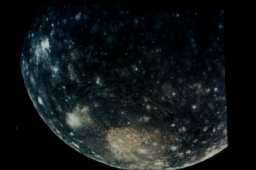This image shows the grooved terrain of Ganymede.
Click on image for full size
NASA
The Grooved Terrain of Ganymede
This image shows an example of the grooved terrain of Ganymede.
The image clearly shows that some things hit Ganymede and made craters after the grooves were made, because the grooves are underneath the craters. This seems to indicate that the grooves were made almost 4 billion years ago, when the period of cratering was just about finished.
A closeup view of these grooves, provided by the Galileo spacecraft, reveals that the ridges are actually many ridges which have been pulled apart as the crust stretched. The spacing between each groove provides information about the underlying crust.
You might also be interested in:

Instead of icy-volcanism, the surface of Ganymede reveals gradual surface deformation and stretching, a stretching similar to the crustal deformation of the Earth. In this case, the folding and stretching
...more
This image shows an example of the light terrain of Ganymede. The image shows the contrast between the light terrain and the dark terrain of Ganymede. The light terrain is where the grooves of Ganymede
...more
The surface of Ganymede is halfway between that of Callisto and that of Europa. Portions of the crust are of ancient age, while other portions are relatively new. The little white dots shown in this image
...more
Amalthea was discovered by E Barnard in 1872. Of the 17 moons it is the 3rd closest to Jupiter, with a standoff distance of 181,300 km. Amalthea is about the size of a county or small state, and is just
...more
Callisto was first discovered by Galileo in 1610, making it one of the Galilean Satellites. Of the 60 moons it is the 8th closest to Jupiter, with a standoff distance of 1,070,000 km. It is the 2nd largest
...more
The insides of most of the moons and planets separated while they were forming out of the primitive solar nebula. Measurements by the Galileo spacecraft have been shown that Callisto is the same inside
...more
Many examples of the differing types of surface are shown in this image. In the foreground is a huge impact crater, which extends for almost an entire hemisphere on the surface. This crater may be compared
...more














